We use cookies to make your experience better. To comply with the new e-Privacy directive, we need to ask for your consent to set the cookies. Learn more.
BREDENT MATERIALS SUPPORT
Heat Absorbent Paste
Overview
There is no better method of protecting against heat. This paste will not melt when warmed. Acrylic, Porcelain, or other heat-sensitive materials are no longer harmed by heat.

Apply the heat absorbent paste very close to the joint.

This paste will not melt when warmed.

Acrylic, porcelain or other heat-sensitive materials are no longer harmed by heat.
MATERIAL SAFETY DATA SHEET
Product Name: HEAT PROTECTION PASTE
Product Code: 540 002 00
Before using this product, please read and follow these instructions carefully.
1. Composition/Information on ingredients
Product Description/use: Mixture of organic binders and mineral fillers in water.
2. Hazard Identification
Hazard codes: According to "GefStoffV", this product is not classified as a hazardous substance.
3. First aid procedures:
Skin contact: Wash with soap, rinse with plenty of water; in case of irritation seek medical assistance. Remove soaked clothing immediately.
Eye contact: Flush eyes immediately with pure water for at least 15 minutes; seek medical assistance.
Ingestion: Drink plenty of water and seek immediate medical attention.
4. Fire fighting procedures:
Suitable extinguishing media: CO2, dry chemicals, water, foam.
Unsuitable extinguishing media: None.
Exposure hazards: None.
Special equipment: None.
5. Accidental release procedures:
Precautions - individuals: Avoid contact with eyes and skin.
Precautions - environment: None.
Cleaning up spillage: Collect & store in a suitable container. After that, clean floor with plenty of water.
6. Storage and handling:
Storage: Store well sealed in a dry place and away from food. Avoid temperatures over 35 C.
Handling: Avoid contact with eyes and kin. When working, plenty of ventilation is required.
7. Exposure control/individual protection
Individual:
Protection-hands: Protective gloves.
Protection-eyes: Protective glasses.
Protection-skin: Working coat (cotton).
General procedures with respect to individual hygiene: Do not eat, drink, or smoke while working. After working, wash your hands with soap and water.
8. Physical and chemical properties:
Appearance: Paste.
Color: Bluish.
Odor: Typical.
Acidity (pH): 5-6.
Solubility in water (20 C; % by weight): Partially soluble.
9. Stability and reactivity:
Conditions to avoid: None.
Materials to avoid: Avoid all substances that will react with water.
Hazardous decomposition products: Thermal decomposition will generate small amounts of carbon-oxides.
10. Toxicological information:
Toxicological evaluation: The toxicological properties have not been fully determined.
Irritating properties: None have been reported yet.
Sensitization: None have been reported yet.
Carcinogenic, teratogenic, or mutagenic effects: None have been reported yet.
11. Ecological information:
No ecological hazards have been reported yet.
12. Disposal consideration:
Product/Soiled container: The product and soiled container have to be disposed in agreement with your local national regulations.
13. Regulatory information
Hazard symbols: According to "GefStoffV", this product is not classified as a hazardous substance.
14. Other information
Data sheet completed by: Research & Development Dept. - Bredent (Germany).
This Material Safety Data Sheet is provided by way of guide for the use of our product and is correct to the best of our knowledge.
However, we can't offer any guarantee as to its accuracy or exhaustiveness. All chemicals may present unforeseen risks and should be used with caution.
We cannot guarantee that the risks referred above are the only risks present. The final choice of the application of a product is thus the sole responsibility of the user.
Microceramic
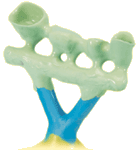
In the field of crowns and bridges, Microceramic is especially suitable for non-precious alloys since very cast surfaces are obtained. The Microceramic is adapted to the expansion of the investment material.

The difference after sandblasting with glass beads can be clearly recognized: The entire oxide layer can be easily removed so that less working time is required.
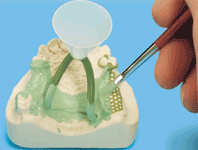
An extended processing time span allows precise application of the Microceramic. Microscopically fine ceramic particles ensure perfect reproduction of very fine details of wax models.
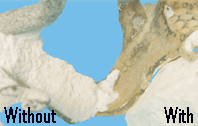
Devesting is simplified since there is no bonding between the investment material and Microceramic.
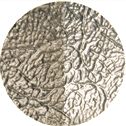
Microceramic avoids extreme formation of oxide on non-precious metal alloys. Cast objects are only sandblasted with 50 micron glass beads to obtain almost perfect high luster. Consequently, time for further processing is saved.
INSTRUCTIONS FOR USE MICROCERAMIC
Before using this product, please read and follow these instructions carefully.
1. Indication Range:
Microceramic is used for non-precious metal alloys in the field of crowns and bridges as well as for CoCr denturework to reduce the oxide layer and to obtain a fine metal surface.
2. Processing
Loosen the Microceramic by slightly pressing the bottle and then shaking it vigorously until a uniform consistency is obtained and the ball moves in the bottle. If required, dilute with distilled water to obtain a creamy consistency.
Use a brush to apply a thin layer of Microceramic onto the wax pattern; ensure that the pattern is completely covered with Microceramic. It is important to avoid the formation of puddles on occlusal surfaces and in the area of the palate. Invest immediately after the Microceramic material has been applied.
After casting, devest the object as usual. Sandblast the Microceramic and adhering oxides using fine or medium coarse abrasive material (110 mµ). Any material for polish blasting can be used for crowns and bridges.
3. Safety Recommendations and Hazard Warnings
" Do not inhale Microceramic dust. The dust contains quartz. In case of repeated exposure, the risk of silicosis exists.
" Microceramic dust should only be removed from the working place with a moist cloth.
" To avoid the formation of dust when deflasking, place the flask into water for a short time after it has cooled down.
" When sandblasting the casting, always use a fine dust filter extraction system.
4. Other Information
The information contained in these instructions is always updated according to the latest knowledge and experience. Therefore, we recommend that you read these instructions again before using a new package. These instructions refer to Microceramic, Item #550 000 12.
MATERIAL SAFETY DATA SHEET
Product Name: MICROCERAMIC
Product Code: 550 000 12
Before using this product, please read and follow these instructions carefully.
1. Composition/Information on ingredients
Product Description/use: Mixture of silicone dioxide with inorganic metal oxide pigments. Contains soda water glass CAS 1344-09-08.
2. Possible hazards:None
3. First aid procedures:
Exposure: Not applicable.
Skin contact: Rinse with plenty of water.
Eye contact: Rinse with plenty of water.
Recommended emergency equipment: Not applicable.
4. Fire fighting procedures:
Suitable extinguishing media: All.
Special hazards caused by the product of its product of combustion: None, this product is not flammable.
5. Accidental release procedures:
After spillage, do not absorb dried material.
6. Storage and handling:
Storage: This product must be stored in dry rooms and in the sealed original container.
Handling: The container must always be closed. General measures of hygiene must be adhered to. Adequate protection measures must be followed.
7. Exposure control/individual protection:
Technical measures: None.
Personal protective equipment: Not applicable.
8. Physical and chemical properties:
Appearance: Paste.
Color: Green.
Odor: None.
Melting point: Not applicable.
Thermal decomposition: Not applicable.
Density: Approx. 1500 kg/m3
Vapor pressure: Not applicable.
pH-Value: Neutral.
Solubility in water: Partly soluble.
Additional information: None.
9. Stability and reactivity:
Conditions to avoid: Not applicable.
Materials to avoid: Not applicable.
Hazardous decomposition products/protection measures: None.
10. Toxicological information:
This product is toxic. If adequate handling is followed, observation of dust protection measures and proper use are ensured, this product will not have any effects that are harmful to health.
11. Ecological information:
This product consists mainly of mineral substances occurring in nature.
Water hazard class: 0 (self-classification).
12. Disposal consideration:
This product can be disposed of together with household waste if the regulations of the local authorities are adhered to.
Disposal method for packaging material: Not applicable.
We would like to point out that national or regional regulations might be applicable.
13. Transport information:
This product is not subject to the regulations on the transport of hazardous products.
14. Regulatory information:
Labeling: Fine investment material is not a hazardous substance according to the definition - Ordinance on Hazardous Materials.
Information on the label: None.
15. Other information
Training information/instructions: Not applicable.
Recommended use/restrictions: Not applicable.
Data sheet completed by: Research & Development Dept. - Bredent (Germany).
This Material Safety Data Sheet is provided by way of guide for the use of our product and is correct to the best of our knowledge. However, we can't offer any guarantee as to its accuracy or exhaustiveness. All chemicals may present unforeseen risks and should be used with caution. We cannot guarantee that the risks referred above are the only risks present. The final choice of the application of a product is thus the sole responsibility of the user.
Retention Beads & Crystals
MATERIAL SAFETY DATA SHEET
Product Name: RETENTION BEADS
Product Code: 530 020 00, 530 020 10, 530 021 00, 530 022 00
Before using this product, please read and follow these instructions carefully.
1. Composition/Information on ingredients
Product Description/use: Expandable polystyrene.
Hazardous Substances: Pentane.
Name: CAS-No. Content Hazard Symbol Hazard Codes
Pentane 109-66-0 F R 18.
2. Possible hazards:
Hazard codes: R 18 This product may generate highly flammable, explosive mixtures with air when used improperly.
3. First aid procedures:
Inhalation: Plenty of fresh air; keep person warm and in case of complications seek medical assistance.
Skin contact: Wash skin with soap and rinse with plenty of water.
Eye contact: Flush immediately with pure water for at least 15 minutes; seek medical attention.
Ingestion: Seek medical attention immediately and present this data sheet to the doctor.
4. Fire fighting procedures:
Suitable extinguishing media: CO2, dry chemicals, or water-spray.
Unsuitable extinguishing media: High-pressure water-jet.
Exposure hazards: Possibly generation of explosive gas-air mixtures, thermal decomposition will lead to the generation of flammable and irritant vapor.
Special equipment: Pressure demand self-contained breathing apparatus be provided to fire fighters.
5. Accidental release procedures:
Precautions - individuals: Wear protective equipment (see section 7), do not allow unprotected persons in room.
Precautions - environment: Avoid discharge into the environment.
Cleaning up spillage: Collect and store in a suitable, labeled container.
Other: Danger of skidding when released.
6. Storage and handling:
Storage: Store dry in well-ventilated rooms only; store away from food.
Conditions to be avoided: Avoid temperatures exceeding 30º C; keep away from all source of ignition - do not smoke; do not expose to direct sunlight.
Handling: Avoid contact with eyes and skin; use in well-ventilated areas and avoid inhaling dust or vapor. Keep away from all sources of ignition while working.
7. Exposure control/individual protection:
Substances with limits relevant to work area:
CAS No. Description Type Value Unit
109-66-0 N-Pentane MAK 1000 ppm
100-42-5 Styrene MAK 20 ppm
Individual:
Protection-hands: Protective gloves.
Protection-eyes: Protective glasses.
Protection-skin: Working coat (cotton).
General procedures with respect to individual hygiene: Do not eat, drink or smoke while working. After working, wash your hands with soap and rinse with water thoroughly.
8. Physical and chemical properties:
Appearance: Solid.
Color: White.
Odor: Typical.
Data relevant to safety:
Melting point/interval: >60º C.
Ignition point: 285º C.
Lower explosion limit: 1.3 % by volume Upper explosion limit: 7.8% by volume
Specific density: 1.05 c/cm3
Solubility in water (20º C; % by weight): Insoluble.
9. Stability and reactivity:
Conditions to avoid: Do not expose to temperatures exceeding 50º C (decomposition).
Materials to avoid: Strong oxidants.
Hazardous decomposition products: Pentane will be released when stored improperly; thermal decomposition will lead to the generation of irritant vapor (styrene).
10. Toxicological information:
Toxicological evaluation: The toxicological properties of this product have not been fully determined.
Irritating properties: None have been reported yet.
Sensitization: None have been reported yet.
Carcinogenic, teratogenic or mutagenic effects: None have been reported yet.
11. Ecological information:
Avoid discharge into the environment.
12. Disposal consideration:
Product/Soiled Container: Product and container can be disposed of with house waste, if in agreement with local and national regulations.
13. Export regulation
Transport: Non-regulated (bottle contains only 20 ml.)
14. Regulatory information:
Hazard symbol & identification:
Hazardous substances: Pentane
Hazard codes: R 18 This product may generate highly flammable and explosive mixtures with air when used improperly.
Safety codes: S 3/9 Store container in a dry and well-ventilated place.
S 16 Keep away from sources of ignition - do not smoke.
S 43 For extinguishing, use water-spray.
15. Other information
Data sheet completed by: Research & Development Dept. - Bredent (Germany).
This Material Safety Data Sheet is provided by way of guide for the use of our product nd is correct to the best of our knowledge.
However, we can't offer any guarantee as to its accuracy or exhaustiveness. All chemicals may present unforeseen risks and should be used with caution.
We cannot guarantee that the risks referred above are the only risks present. The final choice of the application of a product is thus the sole responsibility of the user.
MATERIAL SAFETY DATA SHEET
Product Name: RETENTION CRYSTALS
Product Code: 530 004 80, 530 005 00, 530 005 10
Before using this product, please read and follow these instructions carefully.
1. Composition/Information on ingredients
Product Description/use: Polymer.
2. Hazard Identification
Hazard codes: This product is not regulated by "GefStoffV"; however, exposing it to temperatures exceeding 120º C may lead to the generation of toxic gasses such as ammonia or hydrocyanic acid.
3. First aid procedures:
Inhalation: Plenty of fresh air and in case of complications seek medical assistance.
Skin contact: Wash skin with soap and rinse with plenty of water.
Eye contact: Flush immediately with pure water for at least 15 minutes; seek medical attention.
Ingestion: Usually medical attention is not necessary.
4. Fire fighting procedures:
Suitable extinguishing media: Water, CO2, dry chemicals, foam.
Unsuitable extinguishing media: High-pressure water-jet.
Exposure hazards: Thermal decomposition can lead to the generation of irritant vapor and/or fire.
Special equipment: Pressure demand self-contained breathing apparatus be provided to fire fighters.
5. Accidental release procedures:
Precautions - individuals: None.
Precautions - environment: None.
Cleaning up spillage: Collect and store in a suitable container.
6. Storage and handling:
Storage: Store in a dry place.
Conditions to be avoided: None.
Handling: Use in a well-ventilated area and avoid breathing the vapor when product is burned.
7. Exposure control/individual protection:
Constituents with limits relevant to work area:
CAS No. Description Type Value Unit
107-13-1 Acrylnitrile TRK 3 ppm
106-99-0 Butadiene TRK 5 ppm
100-42-5 Styrene TRK 20 ppm
Individual:
Protection-hands: Protective gloves.
Protection-eyes: Protective glasses.
Protection-skin: Working coat (cotton).
General procedures with respect to individual hygiene: Do not eat, drink or smoke while working. After working, wash your hands with soap and rinse with water thoroughly.
8. Physical and chemical properties:
Appearance: Crystals.
Color: White.
Odor: Typical.
Melting point/interval: 200º C.
Boiling point/interval: 200 C.
Ignition point: 300º C.
Specific density: 1.05 g/ml.
Solubility in water (20º C; % by weight): Insoluble.
9. Stability and reactivity:
Conditions to avoid: None.
Materials to avoid: Strong oxidants.
Hazardous decomposition products: Thermal decomposition can lead to the generation of irritant and harmful gases.
10. Toxicological information:
Toxicological evaluation: Following the general procedures of maintenance of industrial health and safety standards, there should be no toxicological risks.
11. Ecological information:
Avoid discharge into the environment.
12. Disposal consideration:
Product/Soiled Container: Both should be disposed in agreement with local and national legislation.
13. Export regulation
Transport: Non-regulated.
14. Regulatory information:
Hazard symbol & identification: According to GefStoffV, it is not classified as hazardous substance.
15. Other information
Data sheet completed by: Research & Development Dept. - Bredent (Germany).
This Material Safety Data Sheet is provided by way of guide for the use of our product and is correct to the best of our knowledge. However, we can't offer any guarantee as to its accuracy or exhaustiveness. All chemicals may present unforeseen risks and should be used with caution. We cannot guarantee that the risks referred above are the only risks present. The final choice of the application of a product is thus the sole responsibility of the user.
MATERIAL SAFETY DATA SHEET
Product Name: RETENTION ADHESIVE WHITE
Product Code: 540 007 11
Before using this product, please read and follow these instructions carefully.
1. Composition/Information on ingredients
Product Description/use: Solution of binders in a mixture of solvents.
Hazardous substances:
Name: CAS-No. Content Hazard symbols Hazard codes
Acetone 67-64-1 60-70% by w. F R11
Benzyl-alcohol 100-51-6 < 10% by w. Xn R20/22
2. Hazard Identification F - Flammable Xn - Harmful.
Hazard codes R11 Highly flammable.
R20/22 Harmful if swallowed or inhaled. Inhalation of vapor may cause headaches and dizziness.
3. First aid procedures:
Inhalation: Get plenty of fresh air, and in case of complications, seek medical assistance.
Skin contact: Wash with soap, rinse with plenty of water thoroughly; in case of irritation, seek medical attention.
Eye contact: Flush eyes immediately with pure water for at least 15 minutes; seek medical assistance.
Ingestion: Drink plenty of water; seek immediate medical attention.
4. Fire fighting procedures:
Suitable extinguishing media: CO2, dry chemicals, water-spray, foam.
Unsuitable extinguishing media: High-pressure water jet.
Exposure hazards: Thermal decomposition can lead to the generation of irritant vapor and gases and/or fire.
Special equipment: Pressure demand self-contained breathing apparatus should be provided to fire fighters in buildings.
5. Accidental release procedures:
Precautions - individuals: Take care for good ventilation; Wear protective equipment; do not breathe vapor; remove all sources of ignition.
Precautions - environment: Stop leaks as soon as possible and avoid discharge into the environment.
Cleaning up spillage: Absorb with mineral filler (such as sand, diatomaceous earth …) and store in a suitable, well-sealed container.
6. Storage and handling:
Storage: Store in a well-sealed glass container in a well-ventilated room and away from food. Avoid temperatures exceeding 30º C.
Handling: Take care for good ventilation by local or general exhaust; do not breathe vapor, keep away from sources of ignition; do not smoke. Close bottle immediately after use.
7. Exposure control/individual protection:
Relevant to work area:
CAS-No.: Description: Type Value Unit
67-64-1 Acetone MAK 500 ppm
Individual:
Protection-hands: Protective gloves.
Protection-eyes: Protective glasses are recommended.
Protection-skin: Working coat (cotton).
General procedures with respect to individual hygiene: Avoid breathing the vapor; do not eat, drink, or smoke while working. After working, wash your hands with soap and water; observe standard hygiene procedures.
8. Physical and chemical properties:
Appearance: Opaque liquid.
Color: White.
Odor: Typical.
Data relevant to safety:
Melting point/interval: No data available.
Boiling point/interval: 56 C.
Flash point: -17 C.
Ignition point: 465 C.
Self-inflammation: No.
Lower explosion limit: 2.5% by vol. Upper explosion limit: 13% by vol.
Vapor pressure (20 C): 233 mbar
9. Stability and reactivity:
Conditions to avoid: Avoid temperatures exceeding 35 C.
Materials to avoid: Avoid direct contact with strong oxidants.
Hazardous decomposition products: Thermal decomposition can lead to the generation of irritant vapor.
10. Toxicological information:
Toxicological evaluation: The toxicological properties have not been fully determined.
Acute toxicity:
LD50/LC50: Substance Kind of exposure
9750 mg/kg Acetone Oral
2000 mg/kg Benzyl-alcohol Dermal
Irritating Properties: Exposure to vapor for a long period of time may cause headaches, dizziness, and nausea.
Sensitization: None have been reported yet.
Carcinogenic, teratogenic, or mutagenic effects: None have been reported yet.
11. Ecological information:
Avoid discharge into the environment.
12. Disposal consideration:
Product: The product has to be classified as chemical waste material and disposed of in agreement with local and national regulations.
Soiled container: Empty the bottle entirely and allow residues to evaporate in a well-ventilated place. Then dispose of it in agreement with local and national regulations.
14. Regulatory information:
Hazard symbols: F Highly flammable Xn Harmful.
Hazardous substances: Acetone.
Hazard codes: R11 Highly flammable.
R40/22 Harmful if swallowed or inhaled.
Safety codes: S9 Store in well-ventilated rooms only.
S16 Avoid direct contact with sources of ignition-do not smoke.
S20/21 Do not eat or drink while working.
S23 Do not breathe vapor.
S26 In case of contact with eyes, rinse immediately with plenty of water and seek medical attention.
15. Other information
Data sheet completed by: Research & Development Department - Bredent (Germany).
This Material Safety Data Sheet is provided by way of guide for the use of our product and is correct to the best of our knowledge.
However, we can't offer any guarantee as to its accuracy or exhaustiveness. All chemicals may present unforeseen risks and should be used with caution.
We cannot guarantee that the risks referred above are the only risks present. The final choice of the application of a product is thus the sole responsibility of the user.
Transblock
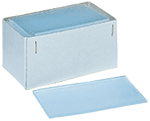
Transparent block-out material for fast and purposeful working in all techniques.

Any desired size or shape of transblock can be produced with the help of an instrument or scissors.

The high flexibility simplifies placing Transblock onto the model.

Due to its stability, a uniform thickness is retained during the adaptation. If required, the thickness can be adapted individually by scraping.

The transparency of Transblock allows to check the thickness of the area that has been blocked out. This way precisely prepared models for individual trays are obtained.
MATERIAL SAFETY DATA SHEET Product Name: TRANSBLOCK Product Code: 540 003 50
Before using this product, please read and follow these instructions carefully.
1. Composition/Information on ingredients
Product Description/Use: Mixture of silicone and mineral fillers.
2. Hazard Identification
Hazard Codes: This product is not regulated by "GefStoffV"; however, direct contact with skin may cause irritation in rare cases.
3. First aid procedures:
Inhalation: Get plenty of fresh air; in case of complications seek medical attention.
Skin Contact: Wash with soap, rinse with plenty of water.
Eye contact: Flush eyes immediately with pure water for at least 15 minutes; seek medical assistance.
Ingestion: In case of complications seek immediate medical attention.
4. Fire fighting procedures:
Suitable extinguishing media: CO2, dry chemicals, water, foam.
Unsuitable extinguishing media: None.
Exposure hazards: Thermal decomposition can lead to the generation of irritant vapor and/or fire.
Special equipment: Pressure demand self-contained breathing apparatus should be provided to fire fighters in buildings.
5. Accidental release procedures:
Precautions - individuals: Use in a well-ventilated area.
Precautions - environment: Avoid discharge into environment.
Cleaning up spillage: Collect and store in a suitable container.
6. Storage and handling:
Storage: Store in a dry place. Avoid temperatures exceeding 35 C; store away from food.
Handling: Keep away from sources of ignition - no smoking.
7. Exposure control/individual protection
Individual:
Protection-hands: Protective gloves.
Protection-eyes: Protective glasses.
Protection-skin: Working coat (cotton).
General procedures with respect to individual hygiene: Do not eat, drink, or smoke while working. After working, wash your hands with soap and water.
8. Physical and chemical properties:
Appearance: Solid.
Color: Transparent.
Odor: Odorless.
Data relevant to safety:
Density (20º C): 1.19 g/ml.
Solubility in water (20 C; % by weight): Insoluble.
9. Stability and reactivity:
Conditions to avoid: Avoid storage temperatures exceeding 35º C.
Materials to avoid: Avoid strong oxidants.
Hazardous decomposition products: Thermal decomposition leads to the generation of irritant and harmful gases.
10. Toxicological information:
Toxicological evaluation: Following the general procedures of maintenance of industrial health and safety standards, there should be no toxicological risks.
Irritating properties: Irritation of skin after direct skin-contact have been reported in rare cases.
11. Ecological information:
Avoid discharge into environment.
12. Disposal consideration:
Product/Soiled container: Both have to be disposed in agreement with your local national regulations.
13. Transport
Transport: Non-regulated.
14. Regulatory information:
Hazard symbols: According to "GefStoffV", this product is not classified as a hazardous substance.
15. Other information
Data sheet completed by: Research & Development Dept. - Bredent (Germany).
This Material Safety Data Sheet is provided by way of guide for the use of our product and is correct to the best of our knowledge.
However, we can't offer any guarantee as to its accuracy or exhaustiveness. All chemicals may present unforeseen risks and should be used with caution.
We cannot guarantee that the risks referred above are the only risks present. The final choice of the application of a product is thus the sole responsibility of the user.
Bredent Tray Material
The flexibility of the material allows easy placement onto the model without tearing. The required shape can be cut with an instrument. The pink color provides the perfect basis for the set-up.
Download MSDS Document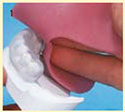
The high flexibility of the material simplifies the placement onto the model. The material will not be damaged.
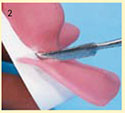
The tray material can be precisely cut with any instrument. Accordingly, the amount of work is reduced.
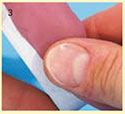
Perfect adaptation to any situation guarantees uniform wall thicknesses.
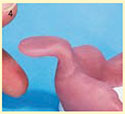
Due to the high stability the position of the handle which has been determined will not be changed during the polymerization process.
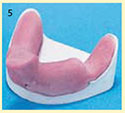
The high stability of the tray material avoids deformation during impression-taking. Precise models will be obtained.
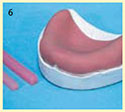
The pink color offers the perfect basis for any type of set-up.
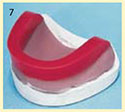
As a basic material for bite patterns or functional trays with bite rims, the resin ensures that the work will not be deformed.





